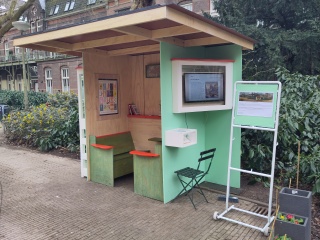Encouraging neighbourliness with outdoor digital neighbourhood stories
01-04-2024

The project 'It takes a village to grow old' is a collaboration in which the research group Digital Life (FDMCI, AUAS) with TU Eindhoven and Stadsdorp Vondel/Helmers in Amsterdam, among others, has been researching AI art objects in public space since April 2022 to encourage encounters between people (with and without dementia) in the neighbourhood. The project responds to the need of people with dementia to continue living at home in the neighbourhood where they feel comfortable and safe.
Sharing neighbourhood stories
After the past two years of research, the Neighbourhood Stories Wall with the Neighbourhood Stories Bench have recently been delivered as concrete results in the practice of the City Village involved.
The Neighbourhood Stories Wall is a place for memories and new stories from the neighbourhood. It is an application that allows stories to be shared, creating more recognition and connection. All neighbours are invited to read and leave stories (together).
If someone runs out of inspiration or has trouble writing, the Neighbourhood Story Wall helps to create a story. In just a few clicks, you can have your own story about a place in the neighbourhood. To do this, the Neighbourhood Story Wall uses AI.
An option to be able to leave your own, open stories about the neighbourhood is currently under development.
Participative method
Digital Life's role in this project is specifically how you can design an AI solution with citizens. In this context, teacher-researcher Saskia Robben conducted several street interviews where citizens from the City Village themselves conducted the interviews. This citizen participation was a common thread throughout the entire study.
Saskia Robben shares the following experiences:
How did you experience the participation of everyone involved in all phases of the research?
'Everyone was extremely involved (and I'm mainly talking about partners from the core team), especially the citizens. I have worked on many projects where co-creation was an important starting point, but rarely have I worked with such committed citizens as in Stadsdorp Vondel/Helmers. Initiatives were often really their responsibility, while my experience as a researcher or project coordinator is that you often have to push them much harder.'
To what extent has the research contributed to social innovation?
'I think that the Urban Village is in itself a form of social innovation, and that this project has further strengthened that structure and collaborations with others.
Specifically with regard to technology and AI, I think we were able to take a group of people through its possibilities and explain some of it, which got them involved.
As a researcher, for example, I noticed a clear difference from the first and the last session with the Urban Village people in the conversation about technology. By the end, I noticed, they have become technologically informed, critical citizens who are well able to discuss the pros and cons of technology (with reasoned arguments and not just from a gut feeling).
Only that increase in digital literacy, or better yet AI literacy, I think is already a gain and a form of social innovation.'

